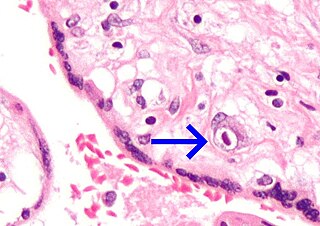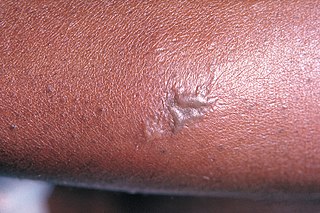
Syphilis is a sexually transmitted infection caused by the bacterium Treponema pallidum subspecies pallidum. The signs and symptoms of syphilis vary depending in which of the four stages it presents. The primary stage classically presents with a single chancre though there may be multiple sores. In secondary syphilis, a diffuse rash occurs, which frequently involves the palms of the hands and soles of the feet. There may also be sores in the mouth or vagina. In latent syphilis, which can last for years, there are few or no symptoms. In tertiary syphilis, there are gummas, neurological problems, or heart symptoms. Syphilis has been known as "the great imitator" as it may cause symptoms similar to many other diseases.

The Tuskegee Study of Untreated Syphilis in the Negro Male was a study conducted between 1932 and 1972 by the United States Public Health Service (PHS) and the Centers for Disease Control and Prevention (CDC) on a group of nearly 400 African American men with syphilis. The purpose of the study was to observe the effects of the disease when untreated, though by the end of the study medical advancements meant it was entirely treatable. The men were not informed of the nature of the experiment, and more than 100 died as a result.

The Wassermann test or Wassermann reaction (WR) is an antibody test for syphilis, named after the bacteriologist August Paul von Wassermann, based on complement fixation. It was the first blood test for syphilis and the first in the nontreponemal test (NTT) category. Newer NTTs, such as the RPR and VDRL tests, have mostly replaced it. During the mid-20th century, in many jurisdictions, including most US states, applicants for a marriage license were required by law to undergo a Wassermann test.
A marriage license is a document issued, either by a religious organization or state authority, authorizing a couple to marry. The procedure for obtaining a license varies between jurisdictions, and has changed over time. Marriage licenses began to be issued in the Middle Ages, to permit a marriage which would otherwise be illegal.

Albert Ludwig Sigesmund Neisser was a German physician who discovered the causative agent (pathogen) of gonorrhea, a strain of bacteria that was named in his honour.

A vertically transmitted infection is an infection caused by pathogenic bacteria or viruses that use mother-to-child transmission, that is, transmission directly from the mother to an embryo, fetus, or baby during pregnancy or childbirth. It can occur when the mother has a pre-existing disease or becomes infected during pregnancy. Nutritional deficiencies may exacerbate the risks of perinatal infections. Vertical transmission is important for the mathematical modelling of infectious diseases, especially for diseases of animals with large litter sizes, as it causes a wave of new infectious individuals.

Sexual health clinics specialize in the prevention and treatment of sexually transmitted infections.

Neurosyphilis is the infection of the central nervous system in a patient with syphilis. In the era of modern antibiotics, the majority of neurosyphilis cases have been reported in HIV-infected patients. Meningitis is the most common neurological presentation in early syphilis. Tertiary syphilis symptoms are exclusively neurosyphilis, though neurosyphilis may occur at any stage of infection.

Marriage law is the legal requirements, an aspect of family law, that determine the validity of a marriage, and which vary considerably among countries.
Venereology is a branch of medicine that is concerned with the study and treatment of sexually transmitted diseases (STDs). The name derives from Roman goddess Venus, associated with love, beauty and fertility. A physician specializing in venereology is called a venereologist. In many areas of the world, the specialty is usually combined with dermatology.
A nontreponemal test (NTT) is a blood test for diagnosis of infection with syphilis. Nontreponemal tests are an indirect method in that they detect biomarkers that are released during cellular damage that occurs from the syphilis spirochete. In contrast, treponemal tests look for antibodies that are a direct result of the infection thus, anti-treponeme IgG, IgM and to a lesser degree IgA. Nontreponemal tests are screening tests, very rapid and relatively simple, but need to be confirmed by treponemal tests. Centers for Disease Control and Prevention (CDC)-approved standard tests include the VDRL test, the rapid plasma reagin (RPR) test, the unheated serum reagin (USR) test, and the toluidine red unheated serum test (TRUST). These have mostly replaced the first nontreponemal test, the Wassermann test.

Gonorrhoea or gonorrhea, colloquially known as the clap, is a sexually transmitted infection (STI) caused by the bacterium Neisseria gonorrhoeae. Infection may involve the genitals, mouth, or rectum. Infected men may experience pain or burning with urination, discharge from the penis, or testicular pain. Infected women may experience burning with urination, vaginal discharge, vaginal bleeding between periods, or pelvic pain. Complications in women include pelvic inflammatory disease and in men include inflammation of the epididymis. Many of those infected, however, have no symptoms. If untreated, gonorrhea can spread to joints or heart valves.

A sexually transmitted infection (STI), also referred to as a sexually transmitted disease (STD) and the older term venereal disease (VD), is an infection that is spread by sexual activity, especially vaginal intercourse, anal sex, oral sex, or sometimes manual sex. STIs often do not initially cause symptoms, which results in a risk of passing the infection on to others. Symptoms and signs of STIs may include vaginal discharge, penile discharge, ulcers on or around the genitals, and pelvic pain. Some STIs can cause infertility.
The Public Health Advisor, or "PHA" is a type of public health worker which was established in 1948 by the United States Public Health Service in the Venereal Disease Control Division. Today they are hired primarily by the U.S. Centers for Disease Control and Prevention (CDC) and serve in many public health programs. This type of worker is unique in public health, because they begin their service at the entry level of public health doing what is known as "field work" or "contact epidemiology" which refers to the interviewing and locating of people who have been exposed to an infectious disease so as to offer them treatment and to reduce the epidemic. Following their initial work experiences, PHAs are exposed to a variety of public health programs across the United States, learning to function at all levels of the public health system. During their time of service, PHAs are called upon to respond to public health or humanitarian crisis. This article will briefly describe the history of the Public Health Advisor and will mention a few notable contributions made over the course of their history with the Public Health Service and later with the Centers for Disease Control and Prevention.
Sexually transmitted infections in the pornography industry deals with the occupational safety and health hazard of contracting sexually transmitted infections (STIs) by workers in the sex industry. Since the 1980s many cases of pornographic performers contracting HIV/AIDS have been reported. However, since the mid-2000s strict adherence to rigorous STI testing, and limiting sexual contact with only fellow tested performers has halted the spread of HIV and other STIs in the industry.

The Guatemala syphilis experiments were United States-led human experiments conducted in Guatemala from 1946 to 1948. The experiments were led by physician John Charles Cutler, who also participated in the late stages of the Tuskegee syphilis experiment. Doctors infected 1,300 people, including at least 600 soldiers and people from various impoverished groups with syphilis, gonorrhea, and chancroid, without the informed consent of the subjects. Only 700 of them received treatment. In total, 5,500 people were involved in all research experiments, of whom 83 died by the end of 1953, though it is unknown whether or not the inoculations were responsible for all these deaths. Serology studies continued through 1953 involving the same vulnerable populations in addition to children from state-run schools, an orphanage, and rural towns, though the intentional infection of patients ended with the original study.
John Charles Cutler was a senior surgeon, and the acting chief of the venereal disease program in the United States Public Health Service. After his death, his involvement in several controversial and unethical medical studies of syphilis was revealed, including the Guatemala and the Tuskegee syphilis experiments.
Applicants for immigration into the United States must meet certain medical standards, as assessed by the Report of Medical Examination and Vaccination Record (I-693). The purpose of the medical exam is to ensure that an applicant is “not inadmissible to the United States on public health grounds." Inadmissibility is defined in Act 212 of the Immigration and Nationality Act (INA). Accordingly, an alien is inadmissible if he or she has a communicable disease of public health significance, lacks the required vaccines, is a drug abuser or addict, or has a physical or mental disorder with a behavior, or history of a behavior, that is a threat to “the property, safety, or welfare of the alien or others”.
The outbreaks of sexually transmitted infections in World War II brought interest in sex education to the public and the government. During the late 1930s and early 1940s, military maneuvers increased worldwide and sexual hygiene and conduct became major problems for the troops. Soldiers and sailors on assignment overseas were often lonely, had time to spare, got homesick, or were just looking for female companionship. This resulted in many men having multiple sex partners, and as a result, became a major health concern. During the Great War, venereal diseases (V.D.) had caused the United States Army to lose 18,000 servicemen per day. Although by 1944, this number had been reduced 30-fold, there were still around 606 servicemen incapacitated daily. This drop in numbers was partly because of the Army's effort to raise awareness about the dangers faced by servicemen through poor sexual hygiene, and also because of the important developments in medicine. In late 1943, a case of gonorrhea required a hospital treatment of 30 days, and curing syphilis remained a 6-month ordeal. By mid-1944, the average case of gonorrhea was reduced to 5 days, and in many cases the patient remained on duty while being treated.

John Friend Mahoney was an American physician best known as a pioneer in the treatment of syphilis with penicillin. He won the 1946 Lasker Award.













